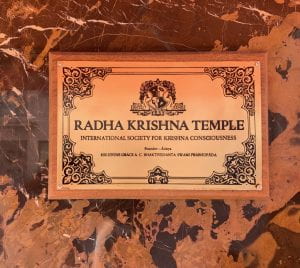Upon visiting the ISKON temple, or the International Society for Krishna Consciousness, in London there were many aspects of the Hare Krishna religion that I was enlightened on. When first walking into to the temple, you would never expect it to look the way that it does on the inside. The outside of the temple gets blended into the consistent London architecture, but upon walking in the inside there are many different cultures that seem to influence the architecture. They have the tight staircases, low level ceilings, and modern appliances that seem to be influenced by the European lifestyles, but also they have extravagant and exotic paintings of the worship room that seem to have influence from what seems to be a Mediterranean and South Asia sources. But then obviously there are the classic Krishna paintings scattered throughout the temple that consistently remind anyone who walks in the purpose of the temple being a place of worship and sanctuary.
But it was what we learned upon entering the temple that really gave a close insight to why and how this religion is still followed today. When we first arrived at the temple, we were first given a presentation on the religion and origins of Hare Krishna. The devotee, Kavi Karnapura, gave us this presentation, and while giving us the origins of the religion and how it spread throughout the world because of their original leader, Abhaya Caranāravinda Bhaktivedānta Svāmi Prabhupada, he also gave us an insight to his personal journey of how he came to be a devotee of Hare Krishna. Kavi Karnapura, shared how he came into the religion because of how it offered a journey to personal self-identity. Karnapura described that the Hare Krishna religion offered him a path to take a step back from traditional authority and gain better personal and spiritual understanding to his own life. This form of finding self-identity is a perfect example of what historian Thomas Hopkin’s explains in his essay ISKCON’s Search for Self-Identity, as he shows that by finding self-identity, it is a journey that one must find through themselves and through the devotion to Krishna (Hopkins 191). This fundamental ideal is not one that just Kavi Karnapura experienced but one that all devotees must experience and is also a big reason to why individuals join and stay in the Hare Krishna movement.
After this lecture on the purpose of Hare Krishna, our group was allowed to take part in a worship ceremony. It was experience unlike anything I had ever experienced before. There was extravagant dancing, singing, praying, and other forms of worshiping. All the devotees worshiping, gave such passion and effort into their various forms of worship, and it was a true test to their strong fundamental belief in the ISKON community and their devotion to Krishna. This worship ceremony provided a good insight into how they praise Krishna and their original leader, Prabhupada, and allowed an interactive experience to all the guests of the ceremony no matter their religious affiliations. It was surprising to see the peaceful, accepting, and nurturing nature of this religion especially because of the negative connotation that the public eye puts on the ISKON community. Overall this was an amazing experience that one can only obtain by attending ISKON temples throughout the world and being open to their beliefs and practices.


